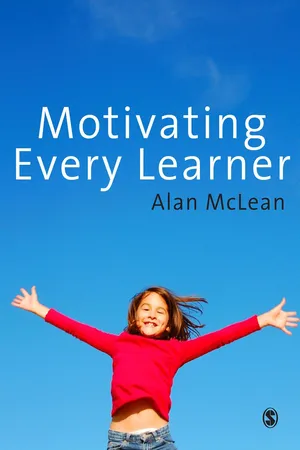![]()
Part One
What makes pupils tick
![]()
1
What makes pupils tick
This chapter outlines the aims and focus of the book, and explores what motivation is about. It gives a preview of the motivation matrix. It argues that misbehaviour is a function of poor motivation and concludes with a description of motivation as a two-way process between teachers and pupils.
This book has been written mainly for teachers but it will be of interest to anyone who wants to develop their ability to motivate others to learn. This depends on the following:
- How do you feel about yourself in your particular role?
- What is your capacity to tune in to people?
- How flexible are you?
The teacher’s tool kit has traditionally consisted of pedagogy to teach the curriculum and disciplinary techniques to control behaviour. This book is not about controlling pupils or shaping their learning progress. It is about understanding what makes them want to engage in learning. The overarching aim of the book is to develop a motivational matrix that synthesizes current thinking about motivation to help generate new knowledge. This matrix enables a deeper understanding of motivation by
- affording you the opportunity for self-reflection
- examining the types of learning environments that can exist in a classroom
- exploring the core conditions for learning and teaching.
The motivation matrix takes the lid off classroom life and develops your understanding of yourself and your pupils. The main priority is to help you to make sense of your own ideas and experiences. The matrix will make connections between ideas and show how the different components relate to each other and fit into the bigger picture. For example, popular concepts such as confidence, emotional intelligence and self-esteem will be integrated into the matrix.
Motivating teaching is intuitive and hard to articulate. The matrix will help you identify where there is scope for improvement. For example, you may not be aware of your teaching style and its impact on your pupils. Hopefully the book will increase your self-awareness and therefore your resilience.
The focus of the book
The central focus of the book is teacher–pupil interactions and how they can promote pupils’ engagement in learning and motivational resilience. Motivational resilience is the capacity to cope with setbacks, adversity, pressure and power. Engagement refers to the intensity and quality of a pupil’s involvement during a task.1 Engaged pupils express their voice and take initiative in trying to produce changes in their environment.2 Disengaged pupils, in contrast, are passive or let external forces control their involvement. Engagement is important because it predicts achievement.3 Young people’s engagement in learning declines over the school years,4 in part due to the way teachers teach.5 On a more positive note, however, pupils’ motivation is easily malleable.6
This book tries to capture the importance of motivation, an issue that ‘stems from the complex interactions between individual psychology, the relationship between teacher and pupil, peer group interactions and the link between school and the outside world’.7 The more you are willing to immerse yourself in the matrix and, in particular, reflect on your own teaching style, the more useful this book will be to you.
What is the biggest lesson you have learned about motivating pupils?
Why do pupils engage differently in different classes?
You may be looking for tips on how to motivate pupils, especially those who are difficult to engage. Motivational teaching, however, cannot be ‘manualized’. The difference between teachers is not down to tips and gimmicks but what kind of teaching style they use. What kind of tip would work for all teachers with all pupils? Consider, for example, the use of praise. Not all teachers are able or willing to give praise and not all pupils are motivated by praise.
Here are some reasonable tips:
- Give high profile responsibilities.
- Negotiate private challenges.
- Maintain familiar routines.
- Surprise them.
Taken together, these tips do not make a lot of sense and contradict each other. Each will work well with some pupils but will drain others. What is the answer? The matrix makes sense of the strategies developed over the years and will also, hopefully, help you generate some new approaches.
The foundation of the matrix is provided by the learner needs. These needs are fundamental to being human and are what pupils are all about. The matrix also describes how teachers and pupils engage with each other, that is, the teaching styles and the learning stances. There is also a layer of the matrix that describes classroom climates and includes a set of general dos, called classroom energizers, and don’ts, called classroom drainers. It also provides a set of stance-specific dos and don’ts.
Think of a range of pupils you know well, or a whole class. Write each pupil’s name on a separate Post-it™. Try to get as wide a range of pupils as possible in terms of what we will call engage-ability.
Now rank order the pupils from high to low engage-ability.
Now cluster them into high, low and average engage-ability.
Consider now what the pupils in your high engage-ability group have in common. What is it about them that made you think of them, that makes them so readily engage-able? Write down your descriptions.
Finally do the same for your low group.
This exercise will enable you to outline and share your understanding of high and low engage-ability. It will be particularly useful to focus on a class and compare your perceptions with colleagues who also teach that class.
When pupils walk into your classroom, they need to feel enthused to learn. Your biggest challenge is that all pupils are motivated in different ways. How can teachers tune into their pupils? The answer lies in recognizing their learning stances. This is your sim card connecting you with the learning network in your classroom.
The learning stances reflect the key differe...


